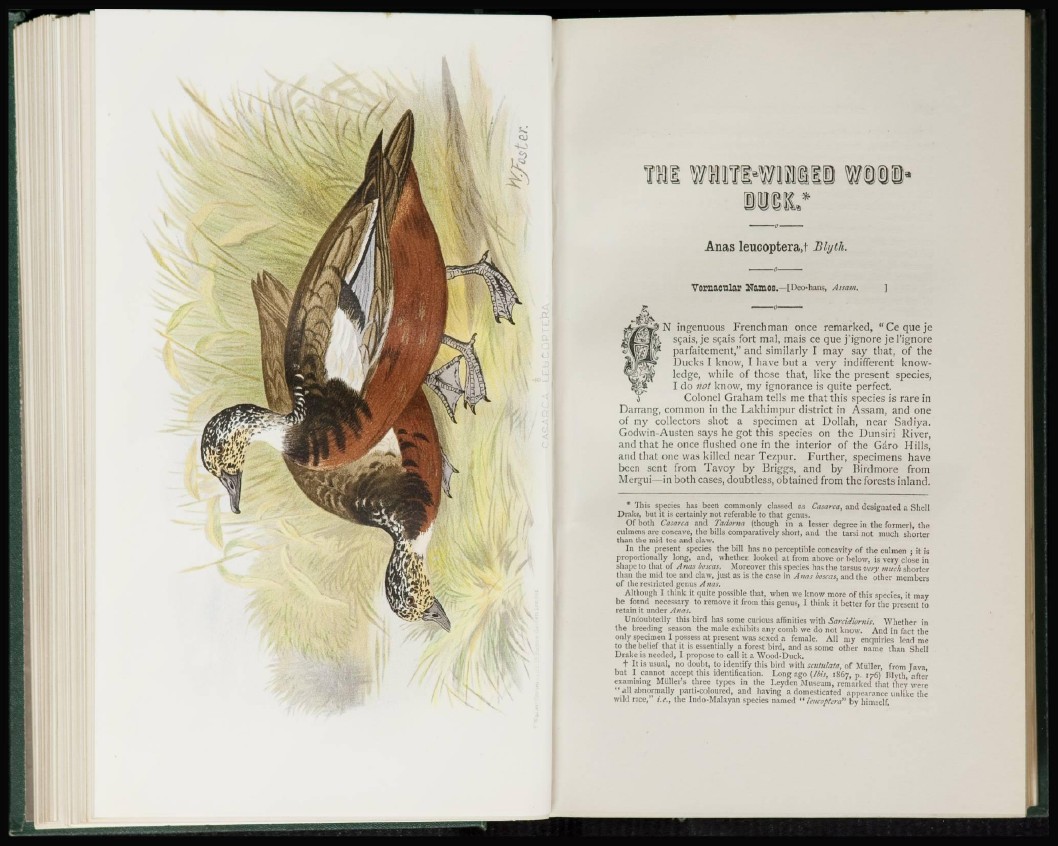
Til OTlIWMli W@»
1 0 C K . *
Anas leucoptera,] BtytK.
Vernacular NamOS.-iDeo-hans, Assam. ]
N ingenuous Fi*enchman once remarked, "Cequeje
s<;ais, je sgais fort mal, mais ce que j'ignore jel'ignore
parfaitement," and similarly I may say that, of the
Ducks I know, I have but a very indifferent knowledge,
while of those that, like the present species,
I do not know, my ignorance is quite perfect,
Colonel Graham tells me that this species is rare in
Darrang, common in the Lakhimpur district in Assam, and one
of my collectors shot a specimen at Dollah, near Sadiya.
Godwin-Austen says he got this species on the Dunsiri River,
and that he once flushed one in the interior of the Garo Hills,
and that one was killed near Tezpur. Further, specimens have
been sent from Tavoy by Briggs, and by Birdmore from
Mergui—in both cases, doubtless, obtained from the forests inland.
* This secies has been commonly classed as Casarca, and designated a Shell
Drake, but it is certainly not referable to that genus.
Of both Casarca and Tadorna (though in a lesser degree in the former), the>
cuhnens arc concave, the bills comparatively short, and the tarsi not much shorter
than the mid toe and claw.
In the present species the bill has no perceptible concavity of the culmen ; it is
proportionally long, and, whether looked at from above or below, is very close in
shape to that of Anas boscus. Moreover this species has the tarsus very much shorter
than the mid toe and claw, just as is the case in Anas boscc.s, and the other members
of the restricted genus Anas.
Although I think it quite possible that, when we know more of this species, it may
be found necessary to remove it from this genus, 1 think it better for the present to
retain it under Anas.
Undoubtedly this bird has some curious afiinilies with Sarcid'wrnis. Whether in
the breeding season the male exhibits any comb we do not know. And in fact the
only specimen I possess at present was scxed a female. All my enquiries lead me
to the belief that it is essentially a forest bird, and as some other name than Shell
Drake is needed, I propose to call it a Wood-Duck.
+ It is usual, no doubt, to identify this bird with scutulata, of Miiller, from Java,
but I cannot accept this identification. Long ago {/his, 1867, p 176) lilyth, after
examining Midler's three types in the Leyden Museum, remaikcd that they wne
" all abnormally parti-coloured, and having a domesticated appearance unlike the
wild race," i.e., the Indo-Malayan species named " ieucoptera" by himself.